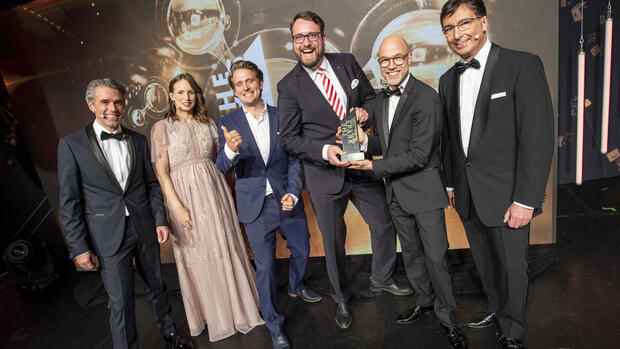The winning team Joachim von Arnim and Alexander Leutner from Cellbricks with Fabian Billing (left), Ina Karabasz, Sebastian Matthes and Niko Mohr.
Berlin Donor organs are rare. Many patients wait years for it. If the start-up Cellbricks has its way, that could soon change: The team is developing a 3D printer for human tissue.
Alexander Leutner, co-head of Cellbricks, said in his two-minute pitch at the German digital prize “The Spark”, awarded by the Handelsblatt and the management consultancy McKinsey: “Following the success of Biontech, we are offering a new therapy revolution.”
With this, Leutner’s team is entering a market worth billions. In 2021, the market volume for bioprinting was 1.7 billion US dollars. The US market research institute Grand View Research predicts that it will increase to over five billion US dollars by 2030.
The start-up wants to use 3D printing to produce implants from real cells. First breast tissue, later organs such as the liver, kidneys and pancreas. With this vision, Leutner’s team took first place in “The Spark”.
Top jobs of the day
Find the best jobs now and
be notified by email.
The jury called the procedure at the award ceremony in Berlin on Thursday evening in Berlin a “quantum leap in medicine”.
Biological breast implants for cancer patients
Leutner described the relevance of the method using breast cancer as an example: every eighth woman in Germany will develop it during her lifetime – that’s 2.3 million a year. In addition to chemotherapy and radiotherapy, in many cases the tumor is surgically removed.
Briefly introduced: Cellbricks
In some cases, doctors remove the entire breast. In order to reconstruct them, implants made of silicone are usually used. This is risky, because the foreign bodies are sometimes encapsulated by the body and also have to be replaced in the course of life.
Cellbricks intends to have developed the process to the point in four years that biological breast implants can be inserted into the human body. The team then wants to focus on organs such as the liver. The process sounds revolutionary and forward-looking. However, it still raises questions and doubts. “How does the tissue know that it is a liver and should behave like one?” asks Niko Mohr, partner at McKinsey, who is moderating the evening together with Handelsblatt department head Ina Karabasz.
Listen to our podcast with brain surgeon Peter Vajkoczy here
The key to the process is creating the right environment for the cells, says Joachim von Arnim from Cellbricks. To print a liver cell, use liver cells. For the print of a pancreas cells of the same organ. “Of course it sounds a bit like science fiction, but it has also been said about gene sequencing that it will take a very long time before it is financially viable,” he says.
>> Read here: Interview with Thomas Südhof on “The Spark” –“As a biologist, it is very difficult not to be fascinated by the brain”
To put this in context: In 2017, the global market volume for DNA sequencing was 6.2 billion US dollars. According to a study by the global market research company Allied Market Research, it is expected to grow to over 25 billion US dollars by 2025.
Plasters from the 3 printer
In initial research projects, the team has provided evidence that the reproduction of cells using printing processes works. For example, together with scientists from the Berlin Institute of Health in the Charité, Cellbricks printed a biological wound closure.
The printer uses gelatine and skin cells to create a plaster that also closes large wounds. Among other things, it could help astronauts on long space trips to treat wounds on site. Leutner and his team want to bring 3D printing to market in the USA by 2027 at the latest.
Cellbricks is also currently intentionally producing diseased tissue to further develop therapies. The Institute for Pathology at the Charité in Berlin, for example, promotes the production of patient-specific tumor models that can be used to develop better chemotherapy, says Leutner.
The jury found that the method can be easily scaled up so that other organs can also be reconstructed in the future.
Founder Lutz Kloke developed the idea during his doctoral thesis. Instead of concentrating on his doctorate, von Arnim says he has become more and more involved with 3D printers. The doctoral thesis “got out of hand in a positive sense,” he says. “We are very grateful.”
More: Organs from the 3D printer and a navigation system for surgeons: These are the winners of “The Spark”
